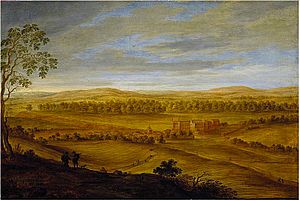Cuthbert Rayne facts for kids
Cuthbert Rayne was an English huntsman, or hunter, who worked for James VI of Scotland. Kings like James VI had special people called huntsmen and kennelmen. Their job was to organize hunting trips and look after the king's hunting dogs. Cuthbert Rayne was one of several English hunters who served King James. Others included Cuthbert Armourer and Edward Dodsworth.
In 1582, new homes for the dogs, called kennels, were built at Holyrood Palace. These were for dogs brought to King James by another English huntsman, Nicholas Poorhouse. Important English nobles sometimes sent dogs as gifts to the king to show their respect. For example, in 1585, Philip Sidney sent a special hunting dog called a "lyme hound."

Contents
Who Was Cuthbert Rayne?
Cuthbert Rayne's family came from a place called Marwood in England. This was near Barnard Castle.
We know more about Cuthbert Rayne thanks to his younger cousin, who was also named Cuthbert Reyne. This cousin wrote that the huntsman Cuthbert Rayne was "in high favour with the King." This means the king liked him a lot. Even when Elizabeth I was still Queen of England, Cuthbert Rayne would visit Scotland every year to hunt with King James.
In 1586, the English ambassador, Thomas Randolph, sent two skilled hunters and a footman to King James. A footman was someone who could make loud noises to scare deer during a hunt. Randolph joked that the footman could make "all the trees in Fawkland will quake for fear." He also told the king to be careful during the hunt!
Cuthbert Armourer, Another Royal Huntsman
Another important English hunter for King James was Cuthbert Armourer. It's sometimes hard to tell if old records are talking about Cuthbert Armourer or Cuthbert Rayne, as both were called "Cuthbert the hunter."
In 1588, one of these Cuthberts received a reward of 20 French crowns. Other English hunters also received money. An official named Archibald Arnot was paid to feed the English huntsmen at Falkland.
Cuthbert Armourer had been in exile, meaning he had to leave England, after a rebellion in 1569. He came to Scotland and worked as a huntsman for King James. By 1583, the English ambassador Robert Bowes reported that King James was very happy with Armourer's hunting skills. Armourer also secretly shared helpful information with the ambassador.
Armourer became very close to King James. He even carried important letters for the king. In 1592, Armourer was present when a Scottish noble, James Stewart, Earl of Arran, met King James at the kennels in Holyroodhouse.
Later, in 1593, King James became suspicious that Cuthbert Armourer might be helping a rebel named Francis Stewart, 5th Earl of Bothwell. The English ambassador assured the king this was not true. Eventually, Armourer was forgiven. After King James became King of both Scotland and England, Cuthbert Armourer was given an important job as Chief Steward of Hexham.
Cuthbert Rayne and the Deer Gift
In April 1592, the English ambassador in Scotland, Robert Bowes, asked Cuthbert Rayne for help. The ambassador wanted to send a gift of deer to King James from Queen Elizabeth I. The deer were meant to live in the park at Falkland Palace.
Cuthbert Rayne, who was a gentleman, traveled to London to meet an important English official, William Cecil. Then he went north to meet Ambassador Bowes. Their plan was to catch 70 deer from places like Barnard Castle and Raby Castle. However, Ambassador Bowes had to return to Scotland quickly, leaving Rayne in charge.
By the end of May, Cuthbert Rayne had caught 21 male deer. But the deer were hurt by the nets and special traps called "buck stawles" that Rayne's men used. The hunting dogs also injured them while chasing them into the nets. Only six deer were loaded onto a Scottish boat at Sunderland and sent to Kirkcaldy for Falkland.
King James was very disappointed with the results. The problem was that the "buck staulls" they used were only good for red deer, not for the fallow deer they were trying to catch. Ambassador Bowes wondered if another gentleman should supervise any future attempts to catch deer.

Later, in 1597, more deer were successfully brought to Scotland. Henry Sackford, the English "Master of Toyles," was paid for collecting 40 deer. In April, James Hudson brought 28 live deer to Scotland. King James even went to Leith to see them. These deer were then taken to Falkland in carts.
Rayne and Dodsworth, Royal Huntsmen
In August 1594, King James VI asked the governor of Berwick-upon-Tweed to let Cuthbert Rayne and another English huntsman, Edward Dodsworth, cross the border into Scotland. The king was surprised they had been stopped. This shows that Rayne often visited Scotland during the hunting season, just as his cousin mentioned.
Edward Dodsworth, who was from East Chevington in England, died in 1630. He was buried at Warkworth. His gravestone has three bugles (hunting horns) carved on it and says he was "huntsman to King James." Edward's brother and nephews also became royal huntsmen.
Robert Rayne, Another Royal Huntsman
In England, a man named Robert Rayne was also a royal huntsman. He was in charge of special hunting dogs called "privy harriers" and "old buck hounds." King James I (who was also James VI of Scotland) later gave these dogs to his son, Henry Frederick, Prince of Wales.
In 1626, King Charles I confirmed Robert Rayne's job as a huntsman for life. Robert Rayne worked with other huntsmen like Walter Rayne, Cuthbert Armourer, and members of the Dodsworth family.

